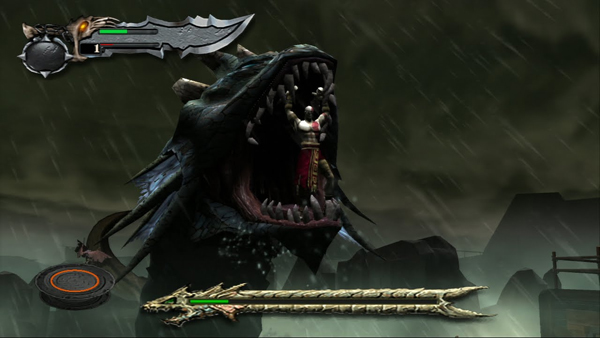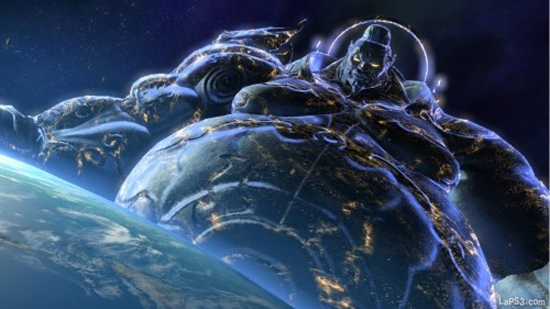Anyone who’s faced off with at least one giant-sized boss knows what it means to be in awe. It’s that spine-tingling, pulse-racing moment when you find yourself in the presence of greatness – or, at least, great girth – and, for one skip of a heartbeat, you’re frozen in place. Rooted to the spot. In a word, awestruck.
Standing before a giant automatically puts us in mind of our own mortality. We can’t help but notice, gazing up at these enormous creatures with mixed wonder and terror, how easily they could crush us, gobble us, or drop-kick us into oblivion. While we admire that power, perhaps even crave it, we also fear it. But why? Does size really matter so much?
Primal Fears: Prehistoric Ties
That shard of fear embedded in our awe of giants can be traced all the way back to the dawn of humanity, when we lived a teensy bit farther down the food chain. Though we arrived too late to the party to get a good look at earth’s true giants, the dinosaurs, we learned pretty quickly that the bigger and badder something looked, the more likely it was that we were about to become its lunch.
To this day, we instinctively assume anything taller than a house and sporting a razor-sharp maw capable of swallowing the world is probably in the mood for a person-sized snack. We know immediately that a T-Rex like the ones found in Turok, Carnivores, and Dino Crisis, is not going to be our friend any time soon, and when a big bad dino bursts through a wall and charges us down like the robo-dinos in 1916: Der Unbekannte Krieg, or the genetically-modified worm in the Penumbra series, it’s probably not because it wants a hug.

At the same time, we also know the bigger they come, the bigger the reward if they fall. Think of the woolly mammoths. Their massive girth made them an obvious threat to any would-be attacker, but it also made them a prime target – bigger meant more meat for food and more materials with which to make clothes, tools, and shelter. This same paradox of survival plays a key role in many an RPG or MMO, and the same bigger-is-better rule applies. The larger (and therefore, generally, more deadly) an enemy is, the more experience and better items the player will get if they vanquish it.
The dragons in Skyrim, for instance, are treasure troves of not only XP but also bones and scales, which fetch a pretty penny and can also be used for making high-level dragonbone armor, and dragon souls, which are spent like currency towards unlocking more powerful Shout spells. Similarly, Skyrim’s giants are one-hit kill horrors who cheerfully sends any foolhardy attacker zooming to the moon, but both the giants and the mammoths they protect yield high XP and decent item drops to anyone strong enough to take them down.

Epic Proportions: Mythological and Religious Roots
The recipe for awe, however, requires more than fear; wonder is necessary, too. As twentieth-century psychologist William McDougall put it, “…we approach it slowly, with a certain hesitation; we are humbled by its presence… the instinct of submission, of self-abasement, is excited, with its corresponding emotion of negative self-feeling, by the perception that we are in the presence of a superior power, something greater than ourselves” (An Introduction to Social Psychology, Revised Edition).
Aside from the obvious impressiveness of sheer size, gigantic beasties have acquired a mythic quality in our collective imagination thanks to our literary history together. Giants have been in our stories for as long as we’ve been telling them. Creatures like the Titans and Cyclops roamed many a fantastical landscapes of ancient mythology (not to mention games like God of War and Castlevania: Lords of Shadow). Classic tales from cultures around the world tell of enormous beings, like Japan’s Daidarabotchi (featured in Ōkamiden) or the frost giant Ymir of Norse legend, whose bulk and brawn were so great they were capable of rearranging the landscape, tossing mountains about just for fun and leaving behind footprints so deep they became lakes.
When we encounter such enormities in video games we tend to recall these stories and unconsciously draw the connection between our current predicament and the magnificent tales of old; we cannot help but feel we are David standing before Goliath. The player becomes a legendary warrior in a battle for honor and glory, and when they stare up at something like the colossi in Shadow of the Colossus or the Leviathan from Dead Space, they are in awe not only of the creature itself, but of the epic narrative of which they have just realized they are the hero.

Similarly, most, if not all, modern organized religions continue to feature some deity, a pantheon of deities, or another higher power of sorts, which is nearly always described as omnipotent, infinite, and beyond mortal ken. Since we cannot see infinity with our limited vision, colossi and their ilk are the closest we can come to a physical, coherent manifestation of such tremendous, unknowable power. This tactic of presenting the infinite in a finite form notably appears in the Megami Tensei franchise: the recurring demon Brahman is based on the Hindu concept of an infinite, perfect reality beyond basic mortal consciousness and Brahmā, the creator god of the Hindu Trinity.
We Might Be Giants: The Battle for Significance
Beyond basic fear or admiration, at the core of our awe of these creatures is something a little more complex: the concept of our own significance, or lack thereof. There’s nothing like a monster capable of swallowing entire planets (see Abadox: The Deadly Inner War) to provide a stark reminder of just how tiny and frail we humans really are. The funny thing is, the more we progress as a species, the more aware of it we become: it’s the old “the more you know, the more you realize you don’t” problem. The bigger we realize the universe is, the smaller we feel in comparison.

Big bad bosses in video games provide us with what I would argue is a valuable outlet for such frustration: like a mountain to a mountaineer, these monsters are more to us than mere Hulk-sized obstacles. They represent the opportunity to turn misfortune into opportunity, the possibility of gaining control of one’s life in the face of overwhelming odds.
In other words, we’re not just in awe of the monster: we’re in awe of the person we might become by defeating the monster. A person brave enough to stand and face the forces of the most impenetrable darkness, like Sora running, keyblade in hand, straight towards Darkside in Kingdom Hearts. A person strong enough to overcome both the giant in question and their own secret fears and weaknesses, like Alice battling the Red Queen at the end of American McGee’s Alice. Someone with determination enough to not only survive the most hideous of realities, but to take the initiative to fight back and change it for the better, like Heather taking down the Order’s evil God at the end of Silent Hill 3.

In fact, we don’t even have to slay the giant. Having one as either a friend or a summon (or both) can provide much the same adrenaline rush, simply because it says the same thing about the player, which is, “You are so d*** awesome, you get to tell this big-a** harbinger of death what to do, and it’ll do it.” In the Final Fantasy franchise, massive summons like Bahamut play a key role in combat, and in Bayonetta the player gets to tell one colossal killing machine to punch another colossal killing machine into the sun. On a lighter note, the plot of Team Ico’s current work-in-progress, The Last Guardian, revolves around a boy who befriends an enormous feline-avian hybrid known as Trico and must learn to work cooperatively with him to survive.
Some games skip the middle man entirely by letting gamers become giants. The most simple scenario of this type features a player-character which has always been (or has already become, before the start of the game) a gigantic being, like the monsters in Rampage and The Movie Monster Game, or mechs like those in Hawken and Strike Suit Zero. Often, the object here is no more and no less than flaunting and enjoying, in a slightly twisted way, the ability to raze entire cities to the ground in the blink of an eye.
Then again, there may be no moment quite so fulfilling as the one in which a normal-sized character suddenly transforms, if only for a little while, into something so colossal it sends previously unstoppable enemies running for the hills. Call it justice or call it revenge – either way, it’s undeniably satisfying to stomp on a bad guy who, up until that moment, was a source of immeasurable stress and innumerable rage quits. Clearly, I speak from experience; for me, the “eat me” cake sequence from Alice: Madness Returns was nothing short of wonderful. I imagine Mario fans feel something similar whenever they get their hands on a Mega Mushroom.

Whether we tame the beast, become the beast, or blast the beast into oblivion, we must remember that size doesn’t really matter. As mentioned earlier, enormity is merely a visual representation of something more important: the ability to overcome, and thus become, something greater than ourselves. At the end of the day, what really matters about humans and giants – whether we’re talking about video games or not – can be summed up in three small words: veni, vidi, vici.

 …WOOLY DESERVES BETTER LOL!
…WOOLY DESERVES BETTER LOL!